The power-up can be found in every genre of gaming, from driving and puzzle games to action-adventures and shooters. They are dropped by defeated enemies, hidden in treasure chests and breakable crates, and sometimes just lying all over the place in the middle of the road.
A well-designed power-up is concentrated action! A player only has to touch it to become energized to move at lightning speeds, blow up the world and return from the dead! The great thing about a power-up is its effects are immediate: who wouldn't want to immediately gain awesome power?! The only downside is that its effects are usually temporary, so use that power wisely. A designer should be wise when creating power-up and ask the following questions:
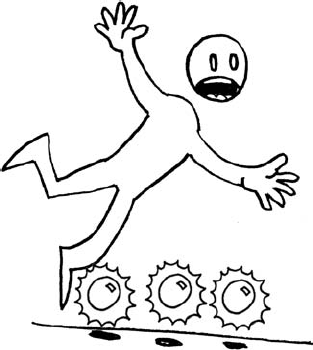
What does the power-up do?
What does it look like? How will it (or its effects) visually stand out in the world? Does it glow or strobe? Rotate or bounce?
Can power-ups be combined or can the player only have one active at once? Can the player retrieve power-ups that are unused or discarded?
How does it affect the player's movement? Rate of speed? Number or type of attacks? Health or status?
How are its effects communicated to the player visually? Aurally?
What is the player's trade-off for using the power-up? Some reduce speed or mobility or the type of moves you can do while under the influence of the power-up.
If the power-up ability is temporary, what cues will let the player know they are about to expire? Is there a HUD element? A visual cue? A sound cue? A music cue? Does it last until you lose a life?
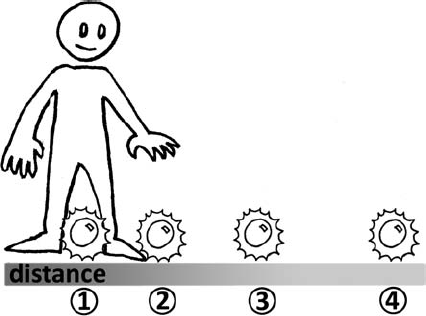
Consider how the player will be collecting the collectable or power-up.
Do they have to walk over it to collect it?
Do they have to reach out and actively choose to pick it up?
Some power-ups are automatically drawn towards the player when they get a certain distance from them. If so, how close does the player have to be, how quickly does this happen and so on?
Perhaps the power-up or collectable is activated when the player gets into its proximity?
Knowing how close the player needs to get will help you determine the effects of the power-up once it's collected.
Power-ups boil down into four categories: defensive, offensive, movement, and game changers.
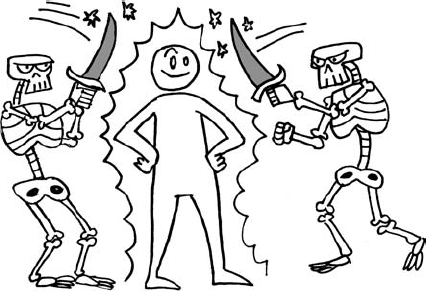
Defensive power-ups help boost the player's ability to survive damage and continue progress in the game. The most common defensive power-ups include:
Health-up: refills the player's health meter. Can be a partial or full refill. If they fill up different amounts, make sure they look different.
Ability recharge: like a health-up but recharges an ability meter rather than the player's health.
Extra life: when collected, the player gains one more life/restart that will allow them to continue the game after they lose all of their health.
Invulnerability: the player cannot be hurt when hit by an enemy or their attack. An invulnerable player is usually still open to affects from hazards that use physics and geometry, (for example, falling off a cliff edge) otherwise problems can arise with collision detection.
Invincibility: as with invulnerability—the player cannot be hurt when hit by an enemy or their attack—but they can also automatically destroy most enemies by colliding with them, as seen in Metroid's screw attack and Mario Kart's super star. Many games don't allow this kind of ability to work on bosses or only cause minor damage.
Protective: temporary forcefields, physical shields, or auras that protect the player from enemy projectiles, fire, or poisonous floors. Protective power-ups may or may not have their own "health meter" to show how much use remains. Protective defenses are different from invulnerability and invincibility because they usually can be improved, modified, and extended by the player.
Indirect attack: commonly found in fast-moving car combat and kart-racing games, this power-up lets the player "fire and forget" smokescreens, oil slicks, and black bombs with fuses on top, causing havoc to those unlucky enemies and players behind them.
Smart bomb: A clear the game screen when things get too tough or the player needs a moment to breathe during all of the action.

Offensive power-ups improve or modify attacks, allowing players to defeat enemies faster, more efficiently, or more spectacularly.
Ammo boost: the player's ammunition is fully restocked. Most ammo boosts pertain to a specific weapon in the player's inventory.
Buffs: from hacking orcs to shooting hoops, these power-ups increase the player's skills and abilities for a short period of time. Awesome flame effects are optional.
Multi-weapon: a power-up that improves your current weapon without fundamentally changing it. Contra's spread attack fires five projectiles in a fan-shaped configuration while heat-seeking rockets will home in on enemies.
Weapon upgrade/swap: this power-up increases the strength, speed, and damage of the player's attack, or can change their weapon to an entirely new one (sometimes more powerful, sometimes as powerful but with differing capabilities that may be more suitable—and hence more useful—in a particular situation). New visuals usually accompany the change. Ghosts 'N Goblins lets the player change from lance to dagger to torch. Flamethrowers, rocket launchers, and shotguns are popular choices.
Damage modifier: Flame! Poison! Ice! Electricity! These power-ups improve the player's base damage, usually accompanied with a dynamic visual.
Direction: this power-up allows the player to change/augment the direction of their attack, most commonly found in shooters to allow the player to shoot behind as well as above and below them. The change in direction can also be applied to the projectile, as in the case of enemy-seeking missiles.
Companion: when picked up, a small object appears next to the player that can provide an additional attack or shielding function. The companion may or may not have hit points. Many last until the player is destroyed or for a specific duration of time. Galaga (Namco, 1981) added the novel twist that a captured ship became your companion. You lost a life, but you gained double shot ability.
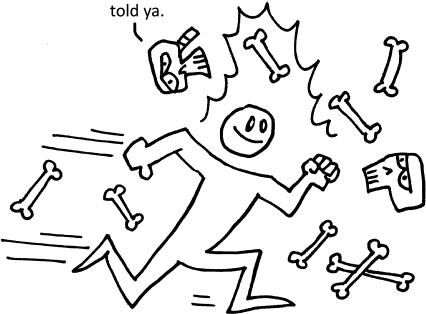
Movement power-ups allow the player to improve their existing movement, or add some new ones. Be particularly careful to account for these power-ups when designing player metrics.
Speed change: nitro boosts and other power-ups allow the player to move at incredible speeds. As a trade-off, the player usually has less control of the vehicle or character because of the faster reaction time needed.
Access: the player gains access to locations normally unreachable via an ability bestowed by the power-up. The access methods are as varied as flying, helicoptering, gliding, and swimming. For example, Mario's bee suit in Super Mario Galaxy.
Size change: depending on the game, changing size can allow a whole suite of abilities, least of which is being able to get into tiny holes. In Super Mario Bros. the super mushroom not only increases the player's size, but it allows the player to take one extra hit, and to break bricks to access new locations. The mini mushroom in New Super Mario Bros. causes Mario to shrink, allowing the player to leap great distances.
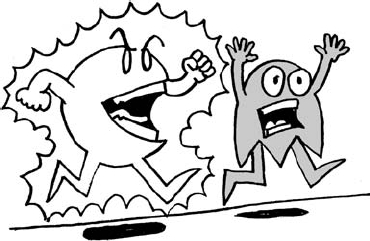
Game changers alter the dynamics of the gameplay and the player's interaction with the game in a significant manner.
Score/treasure modifiers: whether it's a Crazy Taxi fare multiplier or Rock Band's star power, the value of any points/treasure collected by the player is increased for a short period of time.
Change state: this power-up changes the play dynamics in the game. For example, in Pac-Man, the player flees from the enemy ghosts. When he eats a power pellet, the ghosts become vulnerable and the player can become the aggressor.
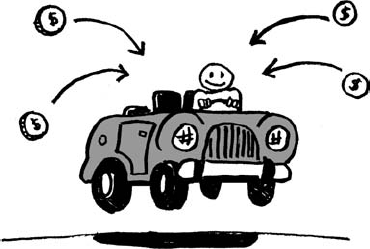
Magnetic: this power-up draws treasure items towards the player, relieving them of the risk of entering dangerous territory or having to "clean up" treasure and collectables after combat.
Invisibility/disguise: the player is rendered temporarily undetectable by enemies and hazards, allowing the player to safely avoid potentially deadly combat and enter locations barred by annoyingly alert guards.
Comedy power-up: a power-up that exists solely to surprise and amuse the player. MDK's "Earthworm Jim" power-up drops a cow onto enemies' heads.
Most power-ups are content to sit still and wait patiently to be consumed by the player, while others have a keen sense of self-preservation. Power-ups have been known to move upon spawning out of their hiding place, like the super mushrooms in Super Mario Bros. Still others will run and hide when they spot the player, like the "cowardly power-up" in MDK. Give your player a chance to catch these mobile power-ups. Do not make them move faster than the player or make them resistant to the lure of a magnetic power-up.

Power-ups can be designed to work conditionally. In Maximo: Ghosts to Glory, we had an armor power-up that only worked when the player had collected the full set of armor. Another one required a special ability to activate. As long as the conditions for gaining these special powers are clear to the player, there's no reason why you can't add this technique to your design arsenal.
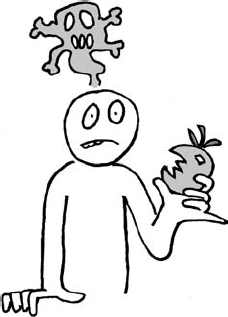
Not all power-ups are delicious and useful. Very evil game designers in their secret lair high in the Alps have created anti-power-ups. Like a chocolate truffle stuffed with dog poo, these sinister collectables look like regular, nice power-ups but they hold a deadly surprise. Poisonous power-ups that can sap health, slow movement, drain experience, or even turn the player into a zombie, complete with backward control schemes. While they are fun, they are only fun once or twice. I suggest using anti-power-ups judiciously and with caution.
Pureiya aishi nasai
Once upon a time, a Japanese game director[158] told me this should be the motto of all game designers. I agree with him, although I have a different way of saying it:
The game designer should be the gentle hand on the rear of the player, pushing them ever upwards[159].
There are many systems that the designer can use to enable the player during the game, and we've already talked about some of them in other chapters: checkpoints, hoists and teeters, aim assist, ramping difficulty. But there are others that are worth discussing: dynamic difficulty balancing, difficulty level adjustment, rubberbanding, game length, and autosave.
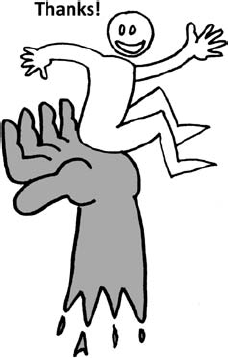
Dynamic difficulty balancing (or DDB) is a way to adjust the challenge and rewards for the player based on performance. For example, if the player dies too often fighting an enemy, then the enemy's health is reduced slightly or the enemy doesn't attack as often. If the player is low on health and opens a treasure chest, a health-up will pop out—but if the player isn't low on health when they open the chest, the player will be rewarded with treasure instead. The goal of DDB is to give the player what they need when they need it in order to propel the player along to success.
Difficulty level adjustment gives a player the option to shift the game down to a lower difficulty setting if too many parameters, such as multiple player deaths, are detected. The player can be given the option to decline or it may be that the adjustment happens automatically. Personally, I don't recommend the latter as many players find it insulting.
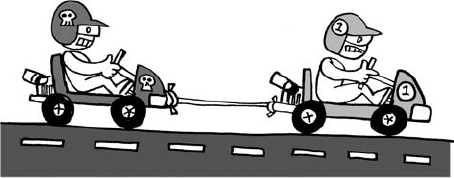
Rubberbanding is used primarily in racing games, but it can be used anytime the player needs to follow or catch any other character or vehicle. If the player gets too far behind, the opponent(s) will slow down enough to let the player catch up. A great solution because racing on an empty track sucks!
The game's length is actually a good tool for adjusting difficulty. Take for example a battle arena. If the player fights bad guys for about 10 minutes, with sufficient health and a modicum of skill, they should be able to survive just fine. However, make that player fight for a half-hour and player fatigue and attrition start to set in. Odds are the player won't survive the encounter. My rule of thumb for gameplay length is this very important thing:
Trust your feelings, Luke. After you play a level a thousand times[160] you will know when your level gets boring. That said, you must be very, very careful as you can develop what I call "designer blinders." Designer blinders occur when you've played your game so many times that you will require a much more difficult level to feel challenged than the consumers, who will only play it a few times. It is a very common problem within game development, which I have seen happen many, many times. We'll talk about how to solve this problem later in Level 17. In the meantime, consolidate your level. Kill the boring parts. Death to boring! Don't be afraid to cut elements if it will make your game better.
Autosaving is when the game periodically records and saves game data automatically. This way, the player can concentrate on playing the game rather than micromanaging their game's save files. Autosave is helpful for when the game crashes[161] or if the player forgets to save their game at a critical part and then dies. Many games autosave whenever loading a new area (for example, Fallout 3).
For every positive example of player difficulty, there is at least one negative one. Here's a story illustrating what I don't mean about how to design player difficulty: I was reviewing an enemy encounter with a creative director. I told him that I thought the encounter wasn't bad, but could stand to be a little more challenging. He agreed and his instructions to me were, "The player has to die three times before they can progress." I thought, "I'm sorry, Mr. Creative Director, I know you are my boss and all, but you are an idiot." But I didn't say it because I wanted to keep my job.
What I did do was not design the encounter so the player had to die three times to progress. And neither should you. Player death should never be a yardstick for game design. "Rewarding" the player with damage or death is negative reinforcement.
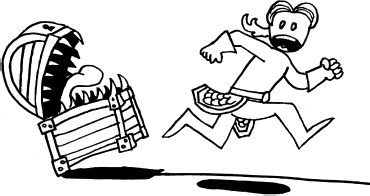
In Maximo, one of the enemies was a treasure chest mimic: a fun enemy that, when "opened" up, snapped and attacked the player like a dog. But it had an unfortunate side effect. I saw players actually cringe before opening a chest because they expected it to be a mimic. While it was fun for the designer to watch the player get tricked, it was not fun for the player. This defeats the point of the game: to have fun. Your players will hate you for it and stop playing the game. This is bad, because the ultimate goal of any game designer should be to keep the player playing. If I ever create this kind of enemy again, I will give some clues to the player so they can spot this enemy and make preparations for it. It can be as simple as a color change or the wobbling pots with an enemy inside in Legend of Zelda: Spirit Tracks.
The way I see it, if the player can play through and finish the entire game, then they will be happy. They will be happy enough to tell others how much they liked your game and they will be happy enough to buy your next game. It's a win-win for all parties involved.
I don't know, I can imagine quite a bit. | ||
| --Han Solo | ||
Game designers have many very powerful tools to keep the player playing: Mystery, delight, pride, and power we've already talked about, but now we come to the two most powerful of these tools: greed and reward.
Greed will get players to do interesting things. They will grind their way through the grindiest MMOs to get that stronger sword, that unique hat, gain that next level. They will jump onto the smallest platform festooned with the deadliest traps just to grab that one additional coin. They will fight the biggest, meanest enemies just to find out what comes next in the story. Or to score that achievement. The following very important thing rings true:
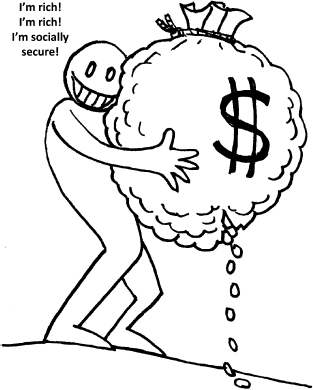
But ... instead of using the player's greed for evil—luring the player to their death to prove that you, the game designer, are cleverer than the player—use their greed for good instead:
Use the promise of treasure and items to motivate players to fight enemies.
Give the player a personal and customizable space to show off their trophies and rewards. Once they start seeing some of the "shelves" filling up, they'll want to "catch them all."
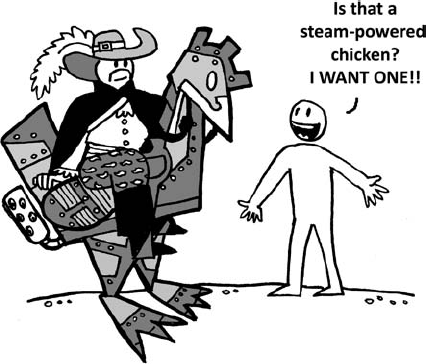
Exploit the "me too" factor. Keeping up with the Joneses is a powerful urge for the player, especially in the multiplayer space. I was once playing World of Warcraft and minding my own business when I saw another player ride by on a mechanical chicken mount. All of a sudden, my player agenda went from "get to the next level" to "MUST OWN ROBOT CHICKEN!"
Create "guidelines" when placing treasure and hidden objects. Sharp players will pick up on these guidelines and their observations will be rewarded. For example, in Maximo: Ghosts to Glory, buried treasure chests were placed next to trees. If there weren't trees in the level, they were hidden next to similar vertical architectural elements like pillars or gravestones.
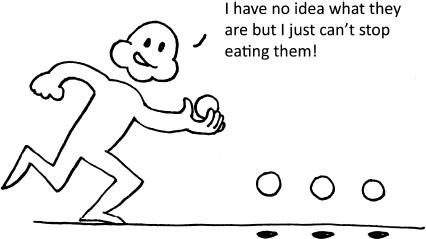
Like the dots in Pac-Man World or rings in any Sonic the Hedgehog game, you can string collectables through the level to guide the player where to go next.
The designers of Half-Life (Valve, 1998) have an interesting method of introducing a new weapon or item to players. First, the player hears about the new item from another character. Second, the player sees the item in the possession of another character. Third, the player sees the item being used by another character and finally, the player obtains and uses the new item for themselves. By the time the new item is in the player's hands, not only have they learned what it looks like, what it is and what it does, but they want it for themselves.
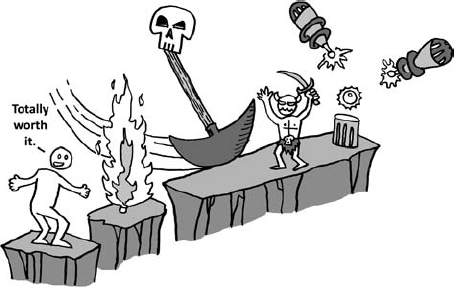
Like greed, rewards are a powerful player motivator. A reward is what the player is ultimately working towards. After all, you can't have a game without a victory condition, and you should never have a victory without a reward.
Expose the player to what rewards are available early in the game. This way they have a laundry list of things "to do" throughout the game and what they will get for achieving them.
Reward the player as soon as possible, reward often, and provide some variety and surprise to the rewards.
A win condition needs to show evidence of success. There's no such thing as enough fanfare. Be dramatic, exciting, and even a little goofy. Or a lot goofy! Set off fireworks, do exciting camera pans around the player, have the player character jump in the air excitedly, play cheering crowds and slot-machine sound effects. Use visual effects and particles, lots and lots of particles! The more, the better! You want the player to feel like they are the victors of World War III, the scorer of the winning run at a baseball game, and a lottery winner all at the same time.
Whatever the reward is, make it matter to the player. Award the player something that gives them the edge on the next level and is the solution to a problem that plagued them on the last. The best reward is the one a player doesn't realize they need until they get it.
In video games, rewards come in many shapes and sizes: scoring, achievements, treasure, loot, power-ups, souvenirs, bonus materials, praise, surprise, and progression.
Back in the prehistoric era of video games[162] the player's only reward was a high score. Scoring is a useful system to showcase the player's success in a very simple way: a number and three little letters. It's a little hard to describe to someone these days why seeing your three initials displayed on an arcade game screen was so exciting, but it was a little like writing your name in wet cement: something the whole world can see to show that YOU were the master of the game—at least until the game's power was turned off for the night and the scoreboard reset[163]. Many gamers thrive on competition, even when it's against themselves, and love having the bragging rights that come with getting a high score. But is scoring in gaming still relevant?
That was the question many game developers asked themselves in the late 1990s. As the arcade scene was dying and most gaming had moved to PCs and home consoles, scoring represented the old school. Scoring was regarded as a remnant of game designs whose sole intent was to keep players dropping quarters into the slot. Scoring soon became regarded as a meaningless number compared to collecting 100% of the game's secrets and finishing the game's story. A simple numeric score just wasn't as sexy or cinematic as a full-blown ending cutscene. Scoring in gaming was almost as dead as the dodo.
Almost.
In the early 2000s, scoring started to matter again with the rising popularity of browser games like Bejeweled (Popcap, 2001) and Feeding Frenzy (Popcap, 2004). When leaderboards were introduced to Xbox Live (and later to the Playstation Network), scoring was off and running again, where it remains a lively part of gaming to this day.
Achievements are high scores with personality. Debuting with Halo 2 on the Xbox 360, achievements motivate players to show off their in-game skills and brag about their accomplishments. Doing a task X number of times; completing game goals like defeating bosses, collecting one specific item (or all of them), or just finishing the game are all valid achievements.
Achievements are great fun for the developer to create—as much as they are for the player to collect. You can give your achievements clever names and fun icons. Usually published before the game's release, achievement lists act as a play "to-do" list. Achievements are a great way for designers to point out gameplay concepts to players that they otherwise may not think of attempting. Achievements can be awarded for anything the developer desires. Here are a few of my favorites:
Easiest achievement ever: press start to play (The Simpsons)
Not bulletproof: died on easy level (50 Cent: Bulletproof)
Street cleaner: hide five dead bodies in bales of hay (Assassin's Creed 2)
Be polite: provide an enemy with a freezecam shot of you doffing your hat (Team Fortress 2)
Six degrees of Schaefer: played with or against any player who has this achievement (which means that at least one player in the chain has played the game with creator Tim Schaefer) (Brütal Legend)
You've wasted your life: be idle for 5 minutes (Saw)
Losing his mind: decapitate a captain with a shield (Conan)
Wheeeeeee!: slide 330 feet continuously through blood (Fairy Tale Fights)
Skidmark: give 50 wedgies (Bully: Scholarship edition)
I feel so funky: get slimed by a charging ghost (Ghostbusters)
Jawa juicer: crush five Jawas by using the grinder in the garbage processing room (The Force Unleashed: Ultimate Sith Edition)
The cake: you found the cake, yummy! (X-Men origins: Wolverine).

Money! Money! Money! Who doesn't love getting treasure? The way the coins jingle merrily when they pop out of a treasure chest... The way they glitter and sparkle on the ground after spilling out of a headless enemy... The way they spin in place, luring you to jump through a flaming hoop of death and over a pit of needle-sharp pungie knives...
Yeah, collecting treasure is great and all, but what are you going to spend it on? In order to make treasure mean anything, you need an economic system. When designing treasure items for your game, create them in escalating values. 1, 5, 10, 50, 100... You get the idea. But don't spread your values too far apart either. The last thing you want is the virtual equivalent of pennies; treasure that no one wants to pick up.
One of the things I love about video games is that I am far richer than I am in real life. A player feels great when they are flush with cash. The benefit of having wads of dough is that the player has lots of choices when shopping—but to do that you have to make sure there are plenty of items for the player to buy. It's always fun to give the player choices between two really good things. Not only do they have the delicious agony over what to buy, but it gives them something to look forward to buying the next time they go shopping. Stock your stores with a variety of things and find ways to rotate the stock to keep the selection from getting stale. Next, determine the price your items will be. Start by classifying your treasure, loot, and other buyable items by their rarity: common, uncommon, rare, and unique. Then apply a price to each of the items. Think about what items you want available to the player from the beginning of the game. Always have some items that can be bought quickly and others that lie tantalizingly out of reach. If I only had a few more coins!
Once you've created a preliminary economy (don't worry about setting it in stone, prices will change over the course of production as you figure out what the player will want or need) then think about placing treasure in the world. If you want the player to be able to afford $300 worth of items, then make sure there is at least $300 worth of treasure in the level. You will have to answer the question, "does treasure regenerate?" If it does, then be aware that players can "mine" levels for treasure, which can completely screw up your economy. On the other hand, replaying a level without any treasure to act as a motivator isn't fun for the player. You may want the player to replay a level multiple times so they can collect enough money to buy what they need. A shortage of funds encourages replay, or exploration off the beaten path. By exposing the player to all the items they could buy at the beginning of the game (via an "ability tree" like in Dante's Inferno), the player can start to plan how they are going to spend their money once they earn it. Sometimes the player might have to buy cheaper and necessary gear like ammo or health-ups in order to progress. Give the player options.
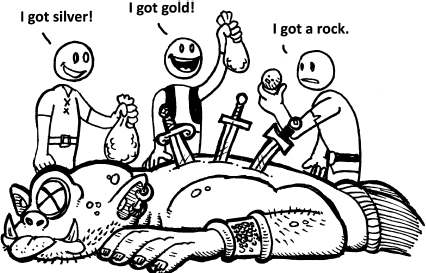
Use color to clarify your treasure's value like the old standbys of copper, silver, and gold. Or use different shapes like coins, bags, and gems. Don't get too diverse or crazy, otherwise players will mistake treasure items for power-ups.
Does your treasure have encumbrance, meaning there is a limit to what the player can carry? If so, then how are they going to carry it? Many RPGs and MMOs have a limit to encumbrance, forcing players to find other storage solutions such as magical bags of holding or a bank. Whatever the solution, make sure that the player doesn't have to shuttle cash from their storage to the store. Just have it come out of the player's account to avoid all of the hassle.
Your treasure doesn't even have to be money. Treasure can be bolts as in Ratchet and Clank, studs as in the Lego games, souls as in God of War series—even trash, such as the bottle caps in Fallout. It doesn't matter what it looks like, as long as it's sparkly and makes a satisfying cha-ching! sound effect when you collect it!

Speaking of all that treasure, where is your player going to spend it? Most RPGs have friendly (and not so friendly) stores that sell all manner of adventuring goods. Borderlands and Bioshock use vending machines. Make your store specific to the game you're making. A racing game could have a garage where players can buy car upgrades and customizations. A sports game could have a sporting goods shop. It's just one more way to add character and theme to your game.
Hey, maybe that slightly creepy guy in the trenchcoat over there in the alley has the magic sword we're looking for? Let's go talk to him.
Who's there? Come in, come in. I have everything the daring hero needs to survive. Take a look around and don't be afraid to ask for help:
Offense. Need a new sword? Lusting after that more powerful gun? How about a nice magic missile spell? It was owned by a little old witch who only used it on Sundays...
Defense. Armor, shields, helmets, forcefield generators: I've got everything that can repel a blade or deflect a laser beam.
Repairs. Swung that sword a little too hard, did ya? Well it will only cost you a few coins to get it swing-worthy again...
Replenishable resources. Ammunition, health potions, batteries, gasoline; we'll get you back up and running again!
Skills. Want to learn a whirlwind sword attack? Or how to add +2 to your accuracy skill? How about a nice set that grants a lock-picking ability? All ya need is some cash...
Access. I've got keys, treasure maps and even a statue that looks like it may fit into a hole. I'll bet it opens a secret door somewhere...
Vanity. That hat looks very stylish on ya. So does that new costume; much better than your old one, if I do say so myself.
Whimsy. Oh, I absolutely think your hair would look better pink, sir. And yes Ma'am, a mustache is just the thing ya need.
Information. For just a few coins, I can tell you where the King is handing out jobs for adventurers such as yourself...
Saves. Only the cruelest of designers would charge someone to keep playing... that will be $100 gold, good sir. Thanks and come again!
Let's get out of this place; it's horribly overpriced, especially since you can find most of this stuff lying around the levels.
Loot is all the great stuff you can buy, but it's FREE! Well, if you consider navigating through the temple of eternal pain and defeating the goblin army free. The difference between loot you buy and loot you find is you should always find much better loot on your adventure. Save the best weapons, the strongest armor, and the shootiest guns for loot. Let the player earn their keep by solving puzzles, surviving hazards, and defeating bosses. And remember this very important thing:
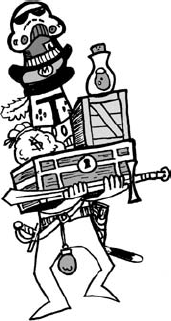
Souvenirs are physical (well, virtual) reminders of the player's adventures during the game. Souvenirs can be displayed back at the player's base or castle or spaceship or condo. Give the player a special place to show them off, like Lara Croft's trophy room in Tomb Raider Anniversary (Eidos, 2006) or a nice shelf with proper lighting. They can be animated interactive exhibits like those found in Lego Indiana Jones: the Original Adventures (Lucasarts, 2008) or virtual museums like the one in Uncharted 2: Among Thieves. No matter which style you choose, use a tight camera or viewer to let the player get a good look at 'em and a label to remind them where they found the souvenir.
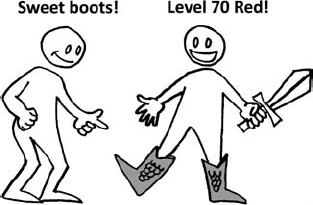
Not all souvenirs should be kept on a shelf. Turning souvenirs into useful game items gives those items more meaning. Defeat the Lich King in World of Warcraft and take his sword. Mega Man takes the powers of the Robot Masters as he defeats them. Instead of awarding a dragon skin rug, why not give the player a pair of dragon skin boots? That way, as long as the player wears the boots, everyone will know who slew the red dragon. Make sure to give the souvenir items special properties too. Those red dragon boots may allow a player resistance to fire attacks or let them walk over hot coals or on lava. It may even give them a special flaming kick attack. Make it special and the player will want to get to the next encounter to see what they can win.
The biggest problem with bonus features is they are usually created at the last minute by the production team. Design them early but they should be one of the last things you create. This way, you can judge just what constitutes a "bonus" to the player by comparing it to the rest of the game's content. Bonus materials may include:
Costume changes. Costume changes help add a little variety—and humor—to your bonus features. The Starkiller from Star Wars: The Force Unleashed can wear costumes from the game's other levels. Kratos in God of War can unlock a business suit or chef's costume.
Alternate models. Create a new look for your hero or villains! In Uncharted 2: Among Thieves players can unlock a fat version of the hero, while in Batman: Arkham Asylum players can turn all the enemies into skeletons.

Alternate modes. Ah, big head mode. You are so easy to code and yet you get so many laughs. Is it any wonder why we love you? Silly modes run the gamut from changing an enemy's exploding body parts into birthday presents to turning all the cars in a game pink. You are only limited by your imagination and how much time you have left in your production schedule.
Downloadable content (DLC). Usually downloaded via console networks like Xbox Live Arcade, Playstation Network or WiiWare, downloadable content can take many forms, including many of those bonuses included on this list. DLC offers a way for games to live beyond their average play life with additional weapons, gameplay modes, achievements, character models, and new levels.
New levels. The most time-consuming of all bonus materials to make, new levels (and game content) is becoming more popular as DLC. By scheduling it as additional material that is released after the game has shipped, the development team can put more time, effort, and polish into the levels—thus keeping up the quality of the material.
Music. Want to listen to the game's music without playing the game? Simple. Create an audio player to allow the player to hear the music. Or you can just let them insert the game disc into a CD player.
Commentary. An audio track of the team talking about the game's development. Starting with Half-Life 2: Lost Coast, developer Valve has made interactive in-game commentary one of their standard bonus features.
"Making of" video. A documentary-style featurette (or feature) that explores the game's creation. These are very time-consuming to make; however, they can be a great way to spotlight your hard-working team.
Model viewers. Players can view the 3-D models and assets in the game. Allow the player camera control to pan around, rotate, and zoom in and out on your models to show them off in the best possible light. This feature is particularly good in games like RTSs, where the characters are normally viewed from a more distant camera angle.
Art viewers. The most common of bonus features: just scan your preproduction art and Voilà! You're done! OK lazy, you can do better than that. Don't be content to just show a slideshow of your team's art. Set the images to music or commentary from the artists. They don't often get a chance to speak up. Show more than just drawings of characters too: show off environments, props, maps, and design materials that will make the player appreciate all the hard work you've put into your games. Make sure the player has control over the pace of the presentation. Don't make them wait around for the next piece of art to appear. How about a magnifier so they can zoom in closely to examine the art? (You can even hide a reward within the art for the player to find!) Or have the player collect pieces of the art to be assembled like a puzzle, which gives a reward based on the artwork when solved.
Promotional materials. Promo materials are more commonly found in sequels as the assets are usually created late in the game's production process. If included with long-standing franchises, they can be particularly interesting for nostalgia purposes.
Trailers. Movie trailers (especially relevant if the game is a movie tie-in), previews of other games, a sneak peak at a sequel. Just don't make watching them mandatory: allow the player the option to skip them.
Minigames. While some whole games are collections of minigames[164], don't forget to include them in bigger games too. They provide the player a chance to take a break from the protracted grind of a longer adventure without ever having to "leave the disc." Give your minigame a place to live, such as an arcade. Minigames are moderately easy to make: just identify some of your game's most fun gameplay and re-contextualize it. In God of War, we did just that—everything in the "Challenge of the Gods" was already in the game code, it just gave the player a different set of victory conditions. Some minigames give rewards that can be used back in the main game's economy system. Sometimes they are promotional tools, as seen in the case of the iPhone game Mass Effect Galaxy, which gives players a reward in Mass Effect 2 for completing it. Or you can just rip-off Galaxian like everyone else.
Multiplayer modes. While describing multiplayer gameplay could take up an entire chapter[165] there are still other modes that aren't directly related to gameplay. Asset trading, chat functions, spectator modes, friends, and rival rosters that allow you to check your friend's game stats—these additional modes will give your game value. Remember to keep their interfaces intuitive and user-friendly. Follow the rules found in Level 8: not too many clicks, keep the game screens down to a minimum, use icons over text, and so on, to keep functions and intent clear.
Alternate endings. Will the player turn out good or evil? Save the world or get blown up? Get the girl or get the boy? Many RPG, adventure, action, and survival horror games offer multiple endings to their stories. Examples include Star Wars: Knights of the Old Republic, the Fable series, Heavy Rain and the games in the Resident Evil series. Multiple endings are a great way to get the player to replay the game, as long as the player knows there are multiple endings to be seen. I've found that it's no longer enough to just have a few different endings based on the decisions made at a few key moments in the game. The struggle between good and evil is much more interesting if they are evenly matched. Build systems and opportunities for the player to "course correct" towards one outcome or another. Make the outcome be the player's choice, rather than one decided by the game.
Cheats. Cheats are usually reserved for use by the development team during production. Cheat modes can be enabled to give the player unlimited resources like health, ammo, lives, or just plain ol' invulnerability. I suggest that you don't enable cheats until the player has played through the game once, otherwise they are CHEATING!!!... themselves out of experiencing the game the way it was meant to be played. Some games go as far as to encourage "proper" play: cheats might not get the "good" ending of a game or they might be marked out as a cheater as in GTA. In Team Fortress 2, anyone who didn't use a cheat received a special wearable angel's halo called "the cheater's lament."

As an industry, we are really, really good about making the player feel really, really bad. We kill player characters at the drop of a hat, force them into near impossible situations, and then mock them when they fail. We'll steal from them in a heartbeat and we'll mess with their minds any chance we can get. What we're not very good at doing is offering praise. And as an industry, we wonder why players complain about games. But as anyone who deals with children knows, praise is the best way to get people to do what you want them to do. What we need to do is make the player feel like the best person in the world instead. The best example I've seen of giving a player praise is in Zak and Wiki: the Quest For Barbaros' Treasure (Capcom, 2007). Whenever the player does something correctly, the following happens:
A "success" musical sting plays.
The hero does a funny reaction or victory animation.
There is a particle effect coming off the hero.
Wiki, the player's monkey sidekick congratulates the player (in text form) on how good they just did; Wiki also has his own musical sting and particle effect.
Not only does all of the above play out whenever the player completes a puzzle, but also:
A burst of special effects tints the screen yellow with streaking stars.
A success musical tune plays, longer than the sting.
A "look at me!" animation from the hero displaying the puzzle piece or item they've just won.
The name of the item the player has just won.
Eight things to support praising the player in the forms of character animation, visual effects, music, and text for solving one puzzle! Fantastic! This game made me feel like I was the smartest player in the world and as a result, I wanted to keep playing! Just remember that you can have too much of a good thing. Praise ceases to be meaningful if you receive it for doing nothing or insignificant acts.
See how often you can stroke the player's ego during the course of the game. NPCs in Fable either recoil in horror or compliment the hero depending on what alignment he is, which is exactly what the player wants to hear, especially since they've spent so much time cultivating their goodness or evil.
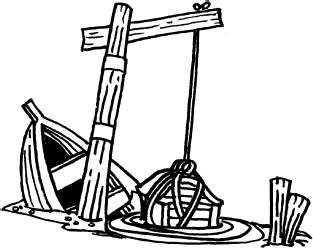
There are other rewards than just treasure... I'm talking about surprise and fun. At Disneyland, Pirate's Lair is a pirate-themed playground. Guests at Pirate's Lair can interact with several items, including a bilge pump and a turn wheel.
As you turn the wheel, a rope on a pulley starts to pull a treasure chest up from underwater. In a video game, once the treasure chest is revealed, the player would get their treasure and go on their way.
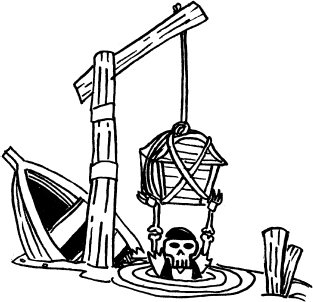
However, if you keep cranking the wheel and raising the chest, a clinging skeleton is revealed who is trying to keep the chest for himself. The skeleton serves no purpose other than to get a laugh out of the viewer. There's no reason why video games can't have little moments like this. Some game developers do similar things such as Marvel Comics creator Stan Lee appearing in Marvel Ultimate Alliance 2, Ape Escape's monkeys in Metal Gear Solid 3's jungle level, or Braid's homage to Mario's World 1-1.
Some will argue that progression isn't much of a reward, and that the player shouldn't be rewarded for merely finishing the game; after all, isn't the point to finish it? There are a lot of things competing for your player's free time. What can be done to keep them engaged? You only need a great story, intriguing level design, ridiculously cool boss battles, and awesome upgrades. Easy, right? But what if more than one player wants to play? Well, that's why we're moving on to Level 14!
Level 13's Universal Truths and Clever Ideas:
Create power-ups that are compatible and complementary to the player's actions and attacks.
Love thy player! Give them the tools to succeed like DDB and rubberbanding.
If something in your game is too difficult or boring, then it is. Get rid of it.
Never underestimate the greed of the player, and use it to prompt interesting scenarios and challenges.
Plan out your economy for the entire game. Price items according to when you want the players to earn them.
Provide enough money for the player so they have choices when shopping.
Have a variety of cool things to buy. Make the player have to choose over (at least) two really good things, so they come back for more.
Determine whether scoring is right for your game, then reward the player when high scores or achievements are obtained.
Don't forget bonus materials and DLC. Remember that it takes time to make this content so don't leave it until the end of your production.
Some rewards are just for fun.
[159] Not as concise, but much more pronounceable.
[160] Honestly, you will play a level a thousand times (at least) between setting it up, populating it, testing the mechanics, hazards and combat, placing the collectibles and readjusting them, and then finally officially play testing it.
[161] But your game isn't going to crash, is it?
[162] Back in those days, the only video games we had to play with were two rocks connected by vines to one bigger rock. Now get off my lawn, you darned kids!
[163] This is why it was always better when you got the high score at a 7-11. Those places NEVER closed!
[164] For examples, just check out most of the games on the Wii.
